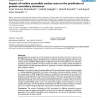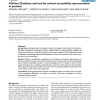27 search results - page 1 / 6 » Impact of residue accessible surface area on the prediction ... |
BMCBI
2008
13 years 4 months ago
2008
Background: The problem of accurate prediction of protein secondary structure continues to be one of the challenging problems in Bioinformatics. It has been previously suggested t...
BMCBI
2004
13 years 4 months ago
2004
Background: Accessible surface area (ASA) or solvent accessibility of amino acids in a protein has important implications. Knowledge of surface residues helps in locating potentia...
BMCBI
2006
13 years 4 months ago
2006
Background: The residue-wise contact order (RWCO) describes the sequence separations between the residues of interest and its contacting residues in a protein sequence. It is a ne...
BMCBI
2008
13 years 4 months ago
2008
Background: Residue depth allows determining how deeply a given residue is buried, in contrast to the solvent accessibility that differentiates between buried and solvent-exposed ...
ICASSP
2007
IEEE
13 years 11 months ago
2007
IEEE
Protein structure prediction aims to determine the three-dimensional structure of proteins form their amino acid sequences. When a protein does not have similarity (homology) to a...


